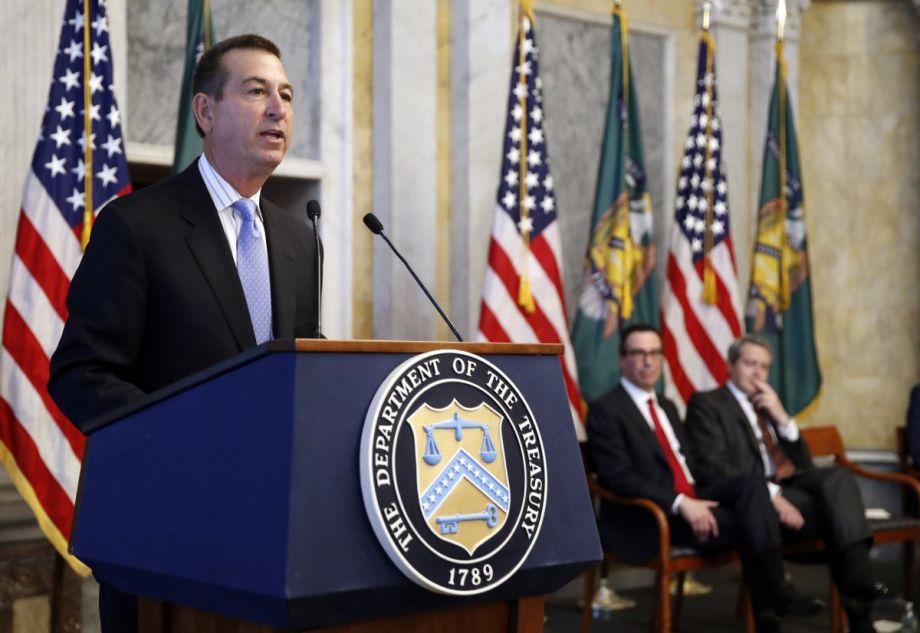In the midst of the COVID-19 pandemic, federal banking regulators are pressing ahead with a massive overhaul of regulations affecting access to credit and banking in the communities hit hardest by that pandemic and the unprecedented economic disruption in its wake.
Yesterday was the deadline for public comments on the regulatory reforms, proposed by the Office of the Comptroller of the Currency and the FDIC. The reforms would dramatically alter how the two agencies enforce the Community Reinvestment Act. Passed by Congress in 1977, the law states that “banks have a continuing and affirmative obligation to help meet the credit needs of the local communities in which they are chartered.”
The last time these regulations were overhauled this significantly was in 1995. While there is widespread consensus that it’s long overdue for an update, there is widespread opposition to the changes as proposed by the Comptroller’s Office and the FDIC.
“The proposal expands what counts for [Community Reinvestment Act] credit with activities that help larger businesses and higher-income families, as well as activities that barely benefit lower-income people or communities and others that could displace these communities,” said Hope Knight, president and CEO of the Greater Jamaica Development Corporation, in a public comment letter dated April 7, 2020.
The Comptroller of the Currency himself, Joseph Otting, couldn’t help but notice the distinct lack of bank branches in Jamaica when he visited the area as part of a series of fact-finding tours he took around the country last fall. And now, the Jamaica section of Queens is one of the neighborhoods hardest hit by COVID-19 in New York City, the epicenter of the pandemic in the United States. A majority of its households are rent-burdened, meaning they pay more than 30 percent of their monthly take-home income in rent, and nearly 90 percent of its residents are black.
Over a thousand public comments have been submitted since the Comptroller’s Office and FDIC unveiled their proposed regulations last December. There might have been many more, as bank watchdog groups, community development corporations and affordable housing developers all across the country had been planning to ramp up campaigns for these past few weeks to encourage more input from the public. But they have instead been consumed with responding to the pandemic and its economic fallout. Many comments received over the past month have been asking to extend the public comment period, or put the entire regulatory process timeline on pause until after the COVID-19 pandemic.
“As you might expect, [the National Congress of American Indians] is juggling quite a bit as it supports tribal nations in dealing with the coronavirus, and we are trying to determine when and how we can work the finalization and submission of our comments on the proposed rule into our work flow in the coming weeks,” said Ian Record, vice president for tribal governance and special projects for the National Congress of American Indians, in a comment letter dated on March 17, 2020.
The original deadline for public comments had actually been March 9, but in February, ceding to calls from advocacy organizations and many in the banking industry, the Comptroller’s Office and FDIC extended the deadline to April 8.
Now that the comment period is closed, the agencies can, at their own discretion, take as long or as little as they want to consider comments and make changes to the final rule before submitting it to the White House Office of Information and Regulatory Affairs, which must conduct an economic analysis. After that, the final rule gets published in the Federal Register, and would go into effect after 60 days.
The Comptroller’s Office and FDIC have stated their intentions are four-fold — to clarify what activities count for Community Reinvestment Act credit; to modernize the method by which banks define the communities they serve, given that online banking has changed the ways banks can reach people and communities even without a physical presence; to provide a more objective assessment of a bank’s impact on communities; and to improve the transparency and timeliness of reporting on bank performance under the law. The agencies say the changes overall will “increase bank activity in low- and moderate-income communities where there is significant need for credit, more responsible lending, greater access to banking services, and improvements to critical infrastructure.”
“Now is precisely the time to modernize CRA regulations so that we can encourage banks and savings associations to provide more lending, investment, and services in the communities they serve across the country, including low- and moderate-income neighborhoods,” says Bryan Hubbard, spokesperson for the Office of the Comptroller of the Currency. “Further delay will prevent these additional resources from reaching those who need them most in this time of national emergency.”
A wide range of groups disagree, from bank watchdog organizations to affordable and fair housing advocates to civil rights organizations to mayors. Many of them have memberships or constituencies among the hardest hit by COVID-19 — black communities.
In Chicago, 70 percent of COVID-19 deaths are black even though only a third of the city’s population is black. The Chicago Urban League, the local chapter of the national civil rights organization, submitted their comments dated January 28. The organization’s concerns begin with pointing out that under the proposed regulations, “banks could get a failing grade in their assessment areas, yet still get a passing grade overall on their CRA examination.”
Currently, regulators assess nearly all banks by giving them one of four grades for each of their branch-based assessment areas, which then get rolled up into an overall grade — “outstanding,” “satisfactory,” “needs to improve,” or “substantial non-compliance.” The latter two are considered failing grades. The proposed framework from the Comptroller’s Office and FDIC suggests that a bank could get a failing grade for up to 50 percent of its branch-based or depositor-based assessment areas, yet still pass its overall examination based on getting credit for eligible activities conducted outside those assessment areas.
Allowing a bank to fail in some of its own assessment areas, some advocates have said, would amount to a new form of legalized redlining.
The Chicago Urban League is also concerned about the proposal to lift the cap on what’s considered a small business under the Community Reinvestment Act, from $1 million to $2 million. The regulators justify this by saying this threshold has not been lifted since it was first set in 1995. But in Chicago, the average black-owned business makes less than one tenth the annual revenue of the average white-owned business. “Enlarging the pool of eligible businesses for CRA-credit might reduce incentives for banks to make smaller loans to entrepreneurs of color and increases competition for these funds,” the Chicago Urban League’s comments read.
“Compounding these disparities is the fact that black entrepreneurs have difficulty accessing credit and receive often less credit than their white peers. The median loan amounts to black businesses ($25,000) is less than half of the median loan amount extended to whites ($58,000),” reads another comment letter, dated March 12, 2020, from the Expanding Black Business Credit Initiative, a coalition of black-led lending organizations focused on lending to black-owned businesses.
Many commenters, from local, state and national bank watchdog groups to community development financial institutions, have also continued raising objections over the proposed use of a “one ratio” as a starting point for evaluating a bank under the Community Reinvestment Act. Known in the framework as the “CRA evaluation measure,” it is primarily calculated by dividing a bank’s aggregated activities that qualify for CRA credit into its deposits, producing a ratio by which a bank would receive a “presumptive” grade that could be adjusted based on deeper analysis. The regulatory agencies argue that it would provide necessary clarity and consistency in CRA enforcement.
And yet the proposal itself notes that, in the pre-proposal comment period that started in September 2018, a majority of public commenters opposed the use of a “single metric.” One of the many comments opposing a “single metric” came from New Orleans — which is facing the same racial disparity in COVID-19 deaths as Chicago.
“The one ratio threatens to render CRA ineffective in making sure banks respond to local needs,” wrote Andreanecia Morris, president/chair of the Greater New Orleans Housing Alliance, in a public comment from November 2018. “While all stakeholders seek clarity in CRA, the one ratio is a solution in search of a problem. Passing CRA exams is not a problem since 98 percent of banks have passed their exams over the last several years.”
Bank watchdog groups have long criticized current regulations for not enforcing the Community Reinvestment Act effectively enough, especially given the frequency with which banks pass their examinations under the law. The law was intended to help correct for the inequalities driven by redlining — the practice of lenders discriminating against certain neighborhoods or people based largely on race. But even as some credit the law with driving trillions of dollars in in loans and investments for affordable housing, small businesses, economic development, and community service facilities in low-income communities and communities of color, in most cities today, the legacy of redlining persists in the form of staggering racial wealth gaps and disparate access to loans for homeownership or small business.
“Given the persistent racial disparities in mortgage and small business lending, the impact of these practices on communities of color should become an explicit focus of CRA exams,” reads one comment letter from Lisa Cylar Barrett, senior policy counsel at the NAACP’s Legal Defense Fund.
As many public comments also point out, the Federal Reserve has not joined the Comptroller’s Office and FDIC’s proposal. All three agencies are responsible for enforcing the law for different sets of banks based on their charter or legal status. The Federal Reserve did outline its own framework last year, though it has not yet moved forward to unveil a full proposal. Two sets of regulations for one law threatens to create even more inconsistency — contrary to the consistency that the Comptroller’s Office and FDIC say they want to produce through this process.
Jumping into the fray last week were a group of prominent institutions who are neither subject to nor supported directly by activities that are eligible for credit under the Community Reinvestment Act — philanthropic foundations. The Presidents’ Council on Impact Investing, a group of 19 foundation presidents representing $80 billion in total endowment assets, issued an April 2 letter opposing the changes proposed by the Comptroller and FDIC and to delay the rulemaking process until after the COVID-19 crisis is over.
“The COVID-19 pandemic and the threat of a prolonged recession or even depression will inflict long-lasting damage on our most vulnerable communities,” the letter reads. “It is in this context that we are calling for the immediate suspension of efforts that could severely undermine the Community Reinvestment Act and rob communities of desperately needed support.”
Many of those foundations were early funders of community development loan funds, banks and credit unions in the 1970s and 1980s that later became federally-certified community development financial institutions, or CDFIs. Then, in the 1990s, funding CDFIs became a consistent and growing way for banks to meet their obligations under the Community Reinvestment Act.
And now, says Fran Seegull, executive director of the U.S. Impact Investing Alliance, which hosts the Presidents’ Council on Impact Investing, those foundations see in this CRA reform process an existential threat to the organizations they helped seed decades ago.
“We see this proposal as providing more incentive to do larger, fewer deals, and less incentive to do more creative and layered deals that lead to the most important community impact,” Seegull says. “The Community Reinvestment Act may or may not affect [foundations’] own direct investments but it touches squarely on the communities they care about.”
This article is part of The Bottom Line, a series exploring scalable solutions for problems related to affordability, inclusive economic growth and access to capital. Click here to subscribe to our Bottom Line newsletter.

Oscar is Next City's senior economic justice correspondent. He previously served as Next City’s editor from 2018-2019, and was a Next City Equitable Cities Fellow from 2015-2016. Since 2011, Oscar has covered community development finance, community banking, impact investing, economic development, housing and more for media outlets such as Shelterforce, B Magazine, Impact Alpha and Fast Company.
Follow Oscar .(JavaScript must be enabled to view this email address)


















